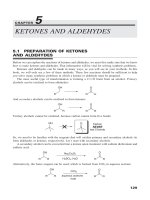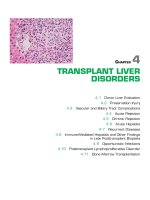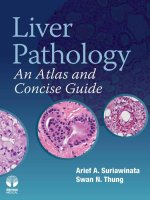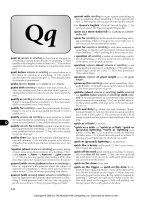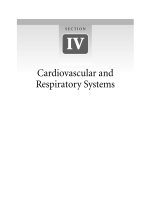Ebook Pulmonary pathology - An atlas and text (3/E): Part 2
Bạn đang xem bản rút gọn của tài liệu. Xem và tải ngay bản đầy đủ của tài liệu tại đây (22.81 MB, 785 trang )
SECTION 12
Small Airways
Sanja Dacic
820
CHAPTER 83
Bronchiolar and
Peribronchiolar
Inflammation, Fibrosis,
and Metaplasia
Sanja Dacic
Small airways may be involved by inflammation and scarring either
as an isolated or focal condition (e.g., a scarred bronchiole from a
prior focal infection) or as a widespread or diffuse process.
Inflammation and scarring of bronchiolar walls and the adjacent
alveolar septa may be accompanied by metaplasia of the
bronchiolar or alveolar epithelium. The bronchiolar epithelium may
undergo goblet-cell metaplasia or squamous metaplasia. The
appearance of bronchiolar-type epithelium on the surface of fibrotic
alveoli next to a scarred bronchiole is sometimes called lambertosis,
which refers to an older concept that this epithelium grew onto the
alveolar surface from the bronchiolar lumen via the canals of
Lambert. Small airways may be a primary site of disease, or most
frequently the scarring and inflammation are the result of
secondary involvement such as in bronchiectasis or
bronchopneumonia.
Histologic Features
◾ Inflammation and scarring in the walls of bronchioles and in the
alveolar septa adjacent to the bronchioles.
821
◾ Goblet-cell metaplasia or squamous metaplasia of the
bronchiolar epithelium.
◾ Bronchiolar metaplasia, goblet-cell metaplasia, or squamous
metaplasia of the surface lining of adjacent scarred alveolar septa
(lambertosis).
Figure 83.1 Small airway scarring extending into
adjacent alveolar septa lined by metaplastic
bronchiolar-type epithelium.
822
Figure 83.2 Small airway submucosal scarring and
prominent bronchiolar metaplasia (lambertosis) in the
adjacent lung parenchyma.
823
Figure 83.3 High-power magnification of bronchiolar
metaplasia.
824
Figure 83.4 Small airways with lymphocytic
inflammation and goblet-cell metaplasia.
Figure 83.5 Mucostasis, a finding frequently seen in
lungs with impaired small airway function.
825
CHAPTER 84
Lobular Pneumonia
Philip T. Cagle
In lobular pneumonia, also called bronchopneumonia or focal
pneumonia, acute inflammation fills the respiratory bronchioles and
adjacent alveolar ducts and alveoli in the center of the lobule. This
is in contrast to lobar pneumonia, which involves an entire lobe.
Generally, lobular pneumonia is caused by an infectious organism.
Specific organisms that can cause pneumonias are discussed in
Chapters 120 to 123.
Histologic Features
◾ Acute inflammation comprising neutrophils fills respiratory
bronchioles and spills into adjacent alveolar ducts and alveoli.
826
Figure 84.1 Low-power view shows neutrophils filling a
bronchiole (lower right) and expanding into the
adjacent alveoli. Other nearby alveoli are filled with
pink edema fluid.
827
Figure 84.2 Higher power view shows bronchiole and
adjacent alveoli filled with neutrophils.
828
CHAPTER 85
Organizing Pneumonia
Sanja Dacic
Organizing pneumonia (OP) is a nonspecific manifestation of a
variety of lung injuries and as a component of several specific lung
diseases. The same histologic pattern occurs as an idiopathic clinical
syndrome called cryptogenic organizing pneumonia (COP; formerly
referred to as idiopathic bronchiolitis obliterans organizing pneumonia),
classified with the idiopathic interstitial pneumonias (see Section 16:
Idiopathic Interstitial Pneumonias). OP may be a primary
manifestation of infections, drug reactions including reaction to
chemotherapy/radiation, bronchiolar obstruction, inhalation of
toxic fumes, and aspiration. This pattern can also be a minor
component of other specific lung diseases, such as hypersensitivity
pneumonitis, eosinophilic pneumonia, or collagen vascular diseases
involving the lungs. OP may also be a nonspecific reaction to
unrelated pathologic processes, such as neoplasms, granulomas, or
infarcts. The morphologic hallmark of OP is the presence of distinct
plugs of granulation tissue (fibroblasts in an edematous or myxoid
stroma) in the bronchiolar lumens and peribronchiolar airspaces.
Rounded nodules of granulation tissue in alveolar spaces are called
Masson bodies. There may be accompanying interstitial lymphocytes
or other inflammation. Transbronchial biopsy may fail to sample
small airways, and the only finding may be the granulation tissue
in the alveoli. Histopathologic clues to the etiology of OP may not
be present, and clinical correlation is often necessary to determine
the underlying cause. If an identifiable etiology is excluded, then
the diagnosis is COP. The OP may resolve with or without residual
scarring.
Histologic Features
829
◾ Plugs of granulation tissue (fibroblasts in an edematous or
myxoid stroma) in the lumens of bronchioles, alveolar ducts, and
adjacent alveoli.
◾ Rounded nodules of granulation tissue in alveolar spaces
(Masson bodies).
◾ There may be accompanying interstitial lymphocytes or other
inflammation.
◾ Transbronchial biopsy may sample only alveoli with granulation
tissue and may not sample involved bronchioles.
◾ Intra-alveolar collections of foamy macrophages indicate
bronchiolar obstruction.
Figure 85.1 OP with granulation-like tissue
proliferation filling airspaces and associated with mild
lymphocytic inflammation. The right lower corner
demonstrates similarly appearing tissue filling the small
airway lumen.
830
Figure 85.2 Higher magnification of a small airway
filled with granulation-like tissue.
831
CHAPTER 86
Constrictive
Bronchiolitis
Sanja Dacic
Constrictive bronchiolitis is a condition in which the bronchiolar
lumens are narrowed by concentric submucosal fibrosis.
Constrictive bronchiolitis may be caused by infection (particularly
viral and mycoplasma), collagen vascular diseases involving the
lungs (particularly rheumatoid arthritis), drug reactions (gold and
penicillamine), and exposures to fumes and toxins. It is most often
encountered following lung or heart–lung transplantation or bone
marrow transplantation when considered to represent a
manifestation of chronic allograft rejection or graft-versus-host
disease, respectively. Constrictive bronchiolitis can also be seen in
patients with bronchiectasis, asthma, or inflammatory bowel
disease. Rapidly progressive dyspnea with cough is the most
common clinical presentation. Prognosis is usually poor, and
steroid therapy is less beneficial. Fully developed constrictive
bronchiolitis showed bronchiolar lumens narrowed and
surrounded by concentric fibrous tissue. Often, only a scar is seen,
and elastic stains may be helpful in demonstrating the remnants of
bronchiole elastica surrounding the fibrosis. Similarly, trichrome
stains may highlight small airway muscle surrounding fibrosis. In
less advanced cases, narrowing of the bronchiolar lumen may be
subtle, and clinical symptoms may be disproportionate to the
morphologic narrowing. Fibrosis does not extend into adjacent
alveolar septa or airspaces. Inflammation may be present, or it may
be minimal or absent.
832
Histologic Features
◾ Bronchiolar lumen is narrowed by submucosal fibrous tissue.
◾ Bronchiolar lumens may be completely obliterated, leaving only
a scar; trichrome stain may help identify obliterated bronchioles
by highlighting their smooth muscle. Elastic stains help to
highlight bronchiole elastica surrounding the fibrosis.
◾ Inflammation may be present, or it may be minimal or absent.
Figure 86.1 Bronchovascular bundle demonstrating a
complete obliteration of the small airway lumen by scar
tissue associated with mild lymphocytic inflammation in
a patient with rheumatoid arthritis.
833
Figure 86.2 High magnification of complete obliteration
of a bronchiolar lumen.
834
Figure 86.3 Trichrome stain highlights bronchiolar
smooth muscle (purple) surrounding luminal scar
(blue).
835
Figure 86.4 Incomplete obliteration of a bronchiolar
lumen by submucosal fibrosis as a manifestation of
chronic allograft rejection in a lung transplant patient.
836
CHAPTER 87
Respiratory
Bronchiolitis and
Membranous
Bronchiolitis
Sanja Dacic
Tobacco smoking results in inflammatory, sometimes fibrotic,
lesions of the membranous (terminal) bronchioles and respiratory
bronchioles, referred to as membranous bronchiolitis and respiratory
bronchiolitis, respectively. If a patient has evidence of interstitial
lung disease, the term used for the same lesion is respiratory
bronchiolitis–associated interstitial lung disease (RB-ILD) or
desquamative interstitial pneumonia. Histologically, respiratory
bronchiolitis and RB-ILD are identical. Mild restrictive defects are
usually found on pulmonary function tests. The process tends to be
stable and may improve, particularly with cessation of cigarette
smoking.
Histologic Features
Respiratory Bronchiolitis
◾ Respiratory bronchioles and adjacent airspaces filled with
macrophages containing a finely granular brown cytoplasmic
pigment.
◾ Mild to moderate infiltrates of lymphocytes and/or histiocytes in
837
the bronchiolar wall; histiocytes may contain black anthracotic
pigment or the same finely granular brown cytoplasmic pigment
as the macrophages.
◾ Minimal to mild fibrosis in the bronchiolar wall and first tiers of
adjacent alveolar septa, which may be lined by hyperplastic type
II pneumocytes or metaplastic bronchiolar epithelium.
Membranous Bronchiolitis
◾ Lesions may be seen involving occasional membranous
bronchioles of smokers or may be more extensive and
accompanied by respiratory bronchiolitis or other smokingrelated changes, such as emphysema and/or desquamative
interstitial pneumonia.
◾ Collections of macrophages containing a finely granular brown
cytoplasmic pigment within lumens of membranous bronchioles
and often in lumens of respiratory bronchioles, alveolar ducts,
and alveoli.
◾ Mild to moderate infiltrates of lymphocytes and/or histiocytes in
the bronchiolar wall, smooth muscle hyperplasia, adventitial
fibrosis, and/or hyperplasia or metaplasia of the bronchiolar
epithelium.
838
Figure 87.1 Respiratory bronchiolitis showing clusters
of pigmented macrophages filling the respiratory
bronchiole lumen and surrounding airspaces.
839
Figure 87.2 High magnification demonstrating the
granular appearance of the macrophage cytoplasm.
840
Figure 87.3 Smoker’s macrophages filling the
respiratory bronchiole lumen and adjacent airspaces.
841
Figure 87.4 Trichrome stain highlights mild fibrosis in
the bronchiolar wall and first tiers of adjacent alveolar
septa.
842
Figure 87.5 Smoking-related lung fibrosis
demonstrates glassy, eosinophilic thickening of the
alveolar septa in the area of emphysematous change.
843
CHAPTER 88
Follicular Bronchiolitis
Sanja Dacic
Follicular bronchiolitis is characterized by hyperplasia of the
bronchus-associated lymphoid tissue (BALT) often containing
germinal centers that is confined to bronchioles. It occurs in a large
spectrum of diseases including collagen vascular diseases involving
the lungs (particularly rheumatoid arthritis and Sjögren syndrome),
in bronchiectasis, in immunodeficiency states (congenital and
acquired). It may also be a manifestation of viral infections,
particularly in children, or a hypersensitivity reaction. Some cases
are idiopathic. It may also be seen in association with lymphoma of
the BALT.
Histologic Features
◾ Prominent lymphoid tissue with follicles and germinal centers
surrounding airways.
844
